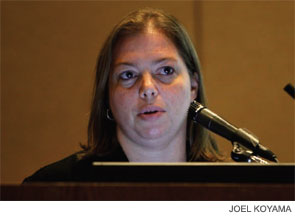Here’s a telling statistic: The average time patients wait in an office to see an otolaryngologist is 24 minutes, according to Press Ganey Associates, Inc., a South Bend, Ind., health care performance measurement and improvement firm. If that doesn’t sound bad, or if you think your practice exceeds that benchmark, consider that otolaryngology ranked 19th in overall satisfaction among 25 medical specialties measured in Press Ganey’s 2010 Medical Practice Pulse Report.

Corticosteroid Confusion: Evidence lacking for most conditions, panelists say
Although steroids are widely used to treat a variety of otolaryngologic conditions, the short- and long-term side effects remain a concern and fuel the need to better understand their proper role. Contributing to the ongoing controversy over their use are gaps in the evidence, panelists said here Sept. 12 at the American Academy of Otolaryngology-Head and Neck Surgery Annual Meeting.
Payment Shifts: Expect reimbursement structure changes ahead, policy experts say
Although the new U.S. health care law does not specifically alter the current fee-for-service payment structure, changes to how physicians and hospitals will be reimbursed for services are under construction. These changes are reflected by the growing focus on the development and implementation of quality improvement and physician and institutional performance measures on which reimbursement will increasingly be made, panelists said here on Sept. 11 at the 2011 American Academy of Otolaryngology-Head and Neck Surgery (AAO-HNS) Annual Meeting.

Personalized Care: Study highlights which patients would benefit from a second round of chemoradiation
Balancing the risks and benefits of concurrent reirradiation and chemotherapy for recurrent head and neck cancers is difficult for physicians at even the most experienced centers. Research recently published in Cancer, however, suggests that selection of patients who may benefit from this therapy should be based on the patient’s previous treatment and the amount of time that has elapsed since initial treatment…

Rent the Right Way: Medical offices require unique leases
As tenants of medical office spaces, physicians often create special leasing issues. Medical tenants use hazardous materials, generate biomedical waste, demand confidentiality of patient records and require compliance with occupational safety standards—all unique aspects of the medical profession. Yet, often, physicians will sign “form” medical office lease agreements provided by the landlord without the benefit of legal counsel. Typically, the landlord provides a standard fill-in-the-blank lease form with the tenant’s name and the general business terms (including the term of lease, rental rate and commencement date). Tenants may gloss over the legal boilerplate provisions included in the lease agreement, assuming that these terms are standard to all leases and are not subject to negotiation.

The Lost Art of Medicine: Patient care is paramount in practice
The science of medicine continues to expand rapidly, and this is obviously good for humanity. The art of medicine, on the other hand, has been largely forgotten. This skill is the basis of the time-honored physician-patient relationship and is an important aspect of good patient care. So why have so many physicians forgotten this basic skill? Why would a caring physician disregard any expertise that would benefit his patient?

Making the Diagnosis: Sleep expert warns about OSA risk in obese children
The most significant danger to children now is obesity, and of the many related comorbidities that affect obese children, obstructive sleep apnea (OSA) will impact a child’s life more than anything else, according to Carole Marcus, MD, an invited lecturer here last month at SLEEP 2011, the 25th Annual Meeting of the Associated Professional Sleep Societies.Dr. Marcus is a professor of pediatrics at the University of Pennsylvania and director of the sleep center at Children’s Hospital of Philadelphia.

An Unofficial First-Line Treatment: Propranolol gains widespread use for infantile hemangiomas
Since the first report in 2008 of the effectiveness of propranolol to treat infantile hemangiomas, its use has grown among physicians who treat these tumors, which arise in 5 to 10 percent of infants. Among these infants, approximately 10 percent will require treatment to correct functional impairment or prevent lasting cosmetic deformity caused by the hemangioma.

Minimizing Risk: Experts share tips on how to manage OSA patients undergoing surgery
For patients undergoing surgery, identification of known or suspected obstructive sleep apnea (OSA) is critical to avoid or minimize surgical complications that are increased in these patients, experts said here last month at SLEEP 2011, the 25th Annual Meeting of the Associated Professional Sleep Societies.

A Prevalent Problem: Studies report sleep deprivation in colleagues, patients
Among the issues highlighted here last month at SLEEP 2011, the 25th Annual Meeting of the Associated Professional Sleep Societies, was the effect of inadequate sleep on both the health of the individual and on society at large. Two studies presented at the meeting, for example, looked at the effects of inadequate sleep on health care providers and the risks posed to their health and the health of their patients. Another study put into context just how underreported inadequate sleep and sleep disorders are and elaborated on the challenge this poses to otolaryngologists and others who are on the frontlines managing these disorders.
- « Previous Page
- 1
- …
- 4
- 5
- 6
- 7
- 8
- …
- 17
- Next Page »